
- •Table of Contents
- •What’s New in EViews 5.0
- •What’s New in 5.0
- •Compatibility Notes
- •EViews 5.1 Update Overview
- •Overview of EViews 5.1 New Features
- •Preface
- •Part I. EViews Fundamentals
- •Chapter 1. Introduction
- •What is EViews?
- •Installing and Running EViews
- •Windows Basics
- •The EViews Window
- •Closing EViews
- •Where to Go For Help
- •Chapter 2. A Demonstration
- •Getting Data into EViews
- •Examining the Data
- •Estimating a Regression Model
- •Specification and Hypothesis Tests
- •Modifying the Equation
- •Forecasting from an Estimated Equation
- •Additional Testing
- •Chapter 3. Workfile Basics
- •What is a Workfile?
- •Creating a Workfile
- •The Workfile Window
- •Saving a Workfile
- •Loading a Workfile
- •Multi-page Workfiles
- •Addendum: File Dialog Features
- •Chapter 4. Object Basics
- •What is an Object?
- •Basic Object Operations
- •The Object Window
- •Working with Objects
- •Chapter 5. Basic Data Handling
- •Data Objects
- •Samples
- •Sample Objects
- •Importing Data
- •Exporting Data
- •Frequency Conversion
- •Importing ASCII Text Files
- •Chapter 6. Working with Data
- •Numeric Expressions
- •Series
- •Auto-series
- •Groups
- •Scalars
- •Chapter 7. Working with Data (Advanced)
- •Auto-Updating Series
- •Alpha Series
- •Date Series
- •Value Maps
- •Chapter 8. Series Links
- •Basic Link Concepts
- •Creating a Link
- •Working with Links
- •Chapter 9. Advanced Workfiles
- •Structuring a Workfile
- •Resizing a Workfile
- •Appending to a Workfile
- •Contracting a Workfile
- •Copying from a Workfile
- •Reshaping a Workfile
- •Sorting a Workfile
- •Exporting from a Workfile
- •Chapter 10. EViews Databases
- •Database Overview
- •Database Basics
- •Working with Objects in Databases
- •Database Auto-Series
- •The Database Registry
- •Querying the Database
- •Object Aliases and Illegal Names
- •Maintaining the Database
- •Foreign Format Databases
- •Working with DRIPro Links
- •Part II. Basic Data Analysis
- •Chapter 11. Series
- •Series Views Overview
- •Spreadsheet and Graph Views
- •Descriptive Statistics
- •Tests for Descriptive Stats
- •Distribution Graphs
- •One-Way Tabulation
- •Correlogram
- •Unit Root Test
- •BDS Test
- •Properties
- •Label
- •Series Procs Overview
- •Generate by Equation
- •Resample
- •Seasonal Adjustment
- •Exponential Smoothing
- •Hodrick-Prescott Filter
- •Frequency (Band-Pass) Filter
- •Chapter 12. Groups
- •Group Views Overview
- •Group Members
- •Spreadsheet
- •Dated Data Table
- •Graphs
- •Multiple Graphs
- •Descriptive Statistics
- •Tests of Equality
- •N-Way Tabulation
- •Principal Components
- •Correlations, Covariances, and Correlograms
- •Cross Correlations and Correlograms
- •Cointegration Test
- •Unit Root Test
- •Granger Causality
- •Label
- •Group Procedures Overview
- •Chapter 13. Statistical Graphs from Series and Groups
- •Distribution Graphs of Series
- •Scatter Diagrams with Fit Lines
- •Boxplots
- •Chapter 14. Graphs, Tables, and Text Objects
- •Creating Graphs
- •Modifying Graphs
- •Multiple Graphs
- •Printing Graphs
- •Copying Graphs to the Clipboard
- •Saving Graphs to a File
- •Graph Commands
- •Creating Tables
- •Table Basics
- •Basic Table Customization
- •Customizing Table Cells
- •Copying Tables to the Clipboard
- •Saving Tables to a File
- •Table Commands
- •Text Objects
- •Part III. Basic Single Equation Analysis
- •Chapter 15. Basic Regression
- •Equation Objects
- •Specifying an Equation in EViews
- •Estimating an Equation in EViews
- •Equation Output
- •Working with Equations
- •Estimation Problems
- •Chapter 16. Additional Regression Methods
- •Special Equation Terms
- •Weighted Least Squares
- •Heteroskedasticity and Autocorrelation Consistent Covariances
- •Two-stage Least Squares
- •Nonlinear Least Squares
- •Generalized Method of Moments (GMM)
- •Chapter 17. Time Series Regression
- •Serial Correlation Theory
- •Testing for Serial Correlation
- •Estimating AR Models
- •ARIMA Theory
- •Estimating ARIMA Models
- •ARMA Equation Diagnostics
- •Nonstationary Time Series
- •Unit Root Tests
- •Panel Unit Root Tests
- •Chapter 18. Forecasting from an Equation
- •Forecasting from Equations in EViews
- •An Illustration
- •Forecast Basics
- •Forecasting with ARMA Errors
- •Forecasting from Equations with Expressions
- •Forecasting with Expression and PDL Specifications
- •Chapter 19. Specification and Diagnostic Tests
- •Background
- •Coefficient Tests
- •Residual Tests
- •Specification and Stability Tests
- •Applications
- •Part IV. Advanced Single Equation Analysis
- •Chapter 20. ARCH and GARCH Estimation
- •Basic ARCH Specifications
- •Estimating ARCH Models in EViews
- •Working with ARCH Models
- •Additional ARCH Models
- •Examples
- •Binary Dependent Variable Models
- •Estimating Binary Models in EViews
- •Procedures for Binary Equations
- •Ordered Dependent Variable Models
- •Estimating Ordered Models in EViews
- •Views of Ordered Equations
- •Procedures for Ordered Equations
- •Censored Regression Models
- •Estimating Censored Models in EViews
- •Procedures for Censored Equations
- •Truncated Regression Models
- •Procedures for Truncated Equations
- •Count Models
- •Views of Count Models
- •Procedures for Count Models
- •Demonstrations
- •Technical Notes
- •Chapter 22. The Log Likelihood (LogL) Object
- •Overview
- •Specification
- •Estimation
- •LogL Views
- •LogL Procs
- •Troubleshooting
- •Limitations
- •Examples
- •Part V. Multiple Equation Analysis
- •Chapter 23. System Estimation
- •Background
- •System Estimation Methods
- •How to Create and Specify a System
- •Working With Systems
- •Technical Discussion
- •Vector Autoregressions (VARs)
- •Estimating a VAR in EViews
- •VAR Estimation Output
- •Views and Procs of a VAR
- •Structural (Identified) VARs
- •Cointegration Test
- •Vector Error Correction (VEC) Models
- •A Note on Version Compatibility
- •Chapter 25. State Space Models and the Kalman Filter
- •Background
- •Specifying a State Space Model in EViews
- •Working with the State Space
- •Converting from Version 3 Sspace
- •Technical Discussion
- •Chapter 26. Models
- •Overview
- •An Example Model
- •Building a Model
- •Working with the Model Structure
- •Specifying Scenarios
- •Using Add Factors
- •Solving the Model
- •Working with the Model Data
- •Part VI. Panel and Pooled Data
- •Chapter 27. Pooled Time Series, Cross-Section Data
- •The Pool Workfile
- •The Pool Object
- •Pooled Data
- •Setting up a Pool Workfile
- •Working with Pooled Data
- •Pooled Estimation
- •Chapter 28. Working with Panel Data
- •Structuring a Panel Workfile
- •Panel Workfile Display
- •Panel Workfile Information
- •Working with Panel Data
- •Basic Panel Analysis
- •Chapter 29. Panel Estimation
- •Estimating a Panel Equation
- •Panel Estimation Examples
- •Panel Equation Testing
- •Estimation Background
- •Appendix A. Global Options
- •The Options Menu
- •Print Setup
- •Appendix B. Wildcards
- •Wildcard Expressions
- •Using Wildcard Expressions
- •Source and Destination Patterns
- •Resolving Ambiguities
- •Wildcard versus Pool Identifier
- •Appendix C. Estimation and Solution Options
- •Setting Estimation Options
- •Optimization Algorithms
- •Nonlinear Equation Solution Methods
- •Appendix D. Gradients and Derivatives
- •Gradients
- •Derivatives
- •Appendix E. Information Criteria
- •Definitions
- •Using Information Criteria as a Guide to Model Selection
- •References
- •Index
- •Symbols
- •.DB? files 266
- •.EDB file 262
- •.RTF file 437
- •.WF1 file 62
- •@obsnum
- •Panel
- •@unmaptxt 174
- •~, in backup file name 62, 939
- •Numerics
- •3sls (three-stage least squares) 697, 716
- •Abort key 21
- •ARIMA models 501
- •ASCII
- •file export 115
- •ASCII file
- •See also Unit root tests.
- •Auto-search
- •Auto-series
- •in groups 144
- •Auto-updating series
- •and databases 152
- •Backcast
- •Berndt-Hall-Hall-Hausman (BHHH). See Optimization algorithms.
- •Bias proportion 554
- •fitted index 634
- •Binning option
- •classifications 313, 382
- •Boxplots 409
- •By-group statistics 312, 886, 893
- •coef vector 444
- •Causality
- •Granger's test 389
- •scale factor 649
- •Census X11
- •Census X12 337
- •Chi-square
- •Cholesky factor
- •Classification table
- •Close
- •Coef (coefficient vector)
- •default 444
- •Coefficient
- •Comparison operators
- •Conditional standard deviation
- •graph 610
- •Confidence interval
- •Constant
- •Copy
- •data cut-and-paste 107
- •table to clipboard 437
- •Covariance matrix
- •HAC (Newey-West) 473
- •heteroskedasticity consistent of estimated coefficients 472
- •Create
- •Cross-equation
- •Tukey option 393
- •CUSUM
- •sum of recursive residuals test 589
- •sum of recursive squared residuals test 590
- •Data
- •Database
- •link options 303
- •using auto-updating series with 152
- •Dates
- •Default
- •database 24, 266
- •set directory 71
- •Dependent variable
- •Description
- •Descriptive statistics
- •by group 312
- •group 379
- •individual samples (group) 379
- •Display format
- •Display name
- •Distribution
- •Dummy variables
- •for regression 452
- •lagged dependent variable 495
- •Dynamic forecasting 556
- •Edit
- •See also Unit root tests.
- •Equation
- •create 443
- •store 458
- •Estimation
- •EViews
- •Excel file
- •Excel files
- •Expectation-prediction table
- •Expected dependent variable
- •double 352
- •Export data 114
- •Extreme value
- •binary model 624
- •Fetch
- •File
- •save table to 438
- •Files
- •Fitted index
- •Fitted values
- •Font options
- •Fonts
- •Forecast
- •evaluation 553
- •Foreign data
- •Formula
- •forecast 561
- •Freq
- •DRI database 303
- •F-test
- •for variance equality 321
- •Full information maximum likelihood 698
- •GARCH 601
- •ARCH-M model 603
- •variance factor 668
- •system 716
- •Goodness-of-fit
- •Gradients 963
- •Graph
- •remove elements 423
- •Groups
- •display format 94
- •Groupwise heteroskedasticity 380
- •Help
- •Heteroskedasticity and autocorrelation consistent covariance (HAC) 473
- •History
- •Holt-Winters
- •Hypothesis tests
- •F-test 321
- •Identification
- •Identity
- •Import
- •Import data
- •See also VAR.
- •Index
- •Insert
- •Instruments 474
- •Iteration
- •Iteration option 953
- •in nonlinear least squares 483
- •J-statistic 491
- •J-test 596
- •Kernel
- •bivariate fit 405
- •choice in HAC weighting 704, 718
- •Kernel function
- •Keyboard
- •Kwiatkowski, Phillips, Schmidt, and Shin test 525
- •Label 82
- •Last_update
- •Last_write
- •Latent variable
- •Lead
- •make covariance matrix 643
- •List
- •LM test
- •ARCH 582
- •for binary models 622
- •LOWESS. See also LOESS
- •in ARIMA models 501
- •Mean absolute error 553
- •Metafile
- •Micro TSP
- •recoding 137
- •Models
- •add factors 777, 802
- •solving 804
- •Mouse 18
- •Multicollinearity 460
- •Name
- •Newey-West
- •Nonlinear coefficient restriction
- •Wald test 575
- •weighted two stage 486
- •Normal distribution
- •Numbers
- •chi-square tests 383
- •Object 73
- •Open
- •Option setting
- •Option settings
- •Or operator 98, 133
- •Ordinary residual
- •Panel
- •irregular 214
- •unit root tests 530
- •Paste 83
- •PcGive data 293
- •Polynomial distributed lag
- •Pool
- •Pool (object)
- •PostScript
- •Prediction table
- •Principal components 385
- •Program
- •p-value 569
- •for coefficient t-statistic 450
- •Quiet mode 939
- •RATS data
- •Read 832
- •CUSUM 589
- •Regression
- •Relational operators
- •Remarks
- •database 287
- •Residuals
- •Resize
- •Results
- •RichText Format
- •Robust standard errors
- •Robustness iterations
- •for regression 451
- •with AR specification 500
- •workfile 95
- •Save
- •Seasonal
- •Seasonal graphs 310
- •Select
- •single item 20
- •Serial correlation
- •theory 493
- •Series
- •Smoothing
- •Solve
- •Source
- •Specification test
- •Spreadsheet
- •Standard error
- •Standard error
- •binary models 634
- •Start
- •Starting values
- •Summary statistics
- •for regression variables 451
- •System
- •Table 429
- •font 434
- •Tabulation
- •Template 424
- •Tests. See also Hypothesis tests, Specification test and Goodness of fit.
- •Text file
- •open as workfile 54
- •Type
- •field in database query 282
- •Units
- •Update
- •Valmap
- •find label for value 173
- •find numeric value for label 174
- •Value maps 163
- •estimating 749
- •View
- •Wald test 572
- •nonlinear restriction 575
- •Watson test 323
- •Weighting matrix
- •heteroskedasticity and autocorrelation consistent (HAC) 718
- •kernel options 718
- •White
- •Window
- •Workfile
- •storage defaults 940
- •Write 844
- •XY line
- •Yates' continuity correction 321
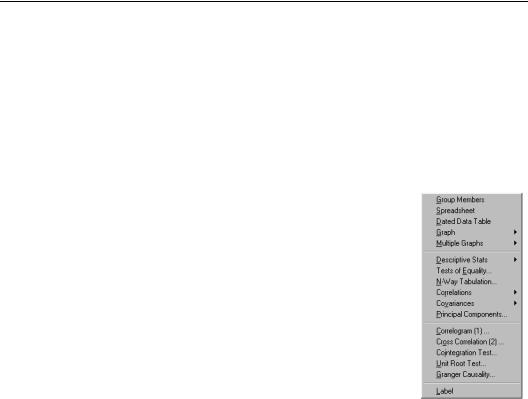
Chapter 12. Groups
This chapter describes the views and procedures of a group object. With a group, you can compute various statistics that describe the relationship between multiple series and display them in various forms such as spreadsheets, tables, and graphs.
The remainder of this chapter assumes that you are already familiar with the basics of creating and working with a group. See the documentation of EViews features beginning with Chapter 4, “Object Basics”, on page 73 for relevant details on the basic operations.
Group Views Overview
The group view menu is divided into four blocks:
•The views in the first block provide various ways of looking at the actual data in the group.
•The views in the second block display various basics statistics.
•The views in the third block are for specialized statistics typically computed using time series data.
•The fourth block contains the label view, which provides information regarding the group object.
Group Members
This view displays the member series in the group and allows you to alter the group. To change the group, simply edit the group window. You can add other series from the workfile, include expressions involving series, or you can delete series from the group.
Note that editing the window does not change the list of group members. Once you make your changes to the list, you must press the UpdateGroup button in the group window toolbar to save the changes.
Spreadsheet
This view displays the data, in spreadsheet form, for each series in the group. If you wish, you can flip the rows and columns of the spreadsheet by pressing the Transpose button. In transpose format, each row contains a series, and each column an observation or date.
Pressing the Transpose button toggles between the two spreadsheet views.

364—Chapter 12. Groups
You may change the display mode of your spreadsheet view to show various common transformations of your data using the dropdown menu in the group toolbar. By default, EViews displays the original or mapped values in the series using the formatting specified in the series (Default). If you wish, you can change the spreadsheet display to show any transformations defined in the individual series (Series Spec), the underlying series data (Raw Data),
or various differences of the series (in levels or percent changes), with or without log transformations.
You may edit the series data in either levels or transformed values. The Edit +/- on the group toolbar toggles the edit mode for the group. If you are in edit mode, an edit window appears in the top of the group window and a double-box is used to indicate the cell that is being edited.
Here, we are editing the data in the group in 1-period percent changes (note the label to the right of the edit field). If we change the 1952Q4 value of the percent change in GDP,
from 3.626 to 5, the values of GDP from 1952Q4 to the end of the workfile will change to reflect the one-time increase in the value of GDP.
EViews provides you with additional tools for altering the display of your spreadsheet. To change the display properties, select one or more series by clicking on the series names in the headers, then right-click to bring up a menu.
If you right-click and then select Display format... EViews will open a format dialog that will allow you to override the individual series display characteristics. Once you specify the desired format and click on OK, EViews will update the group display to reflect your specification.
Note that, by default, changes to the group display format will apply only to the group spreadsheet and will not change the underlying series characteristics. If, for example, you elect to show series X in fixed decimal format in the group spreadsheet, but X uses significant digits in its individual series settings, the latter settings will not be modified. To update the display settings in the selected series, you must select the Apply to underlying series checkbox in the format dialog.
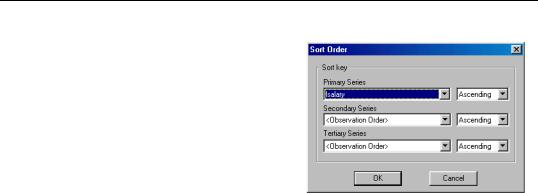
Dated Data Table—365
Most of the other right-mouse menu items should be self-explanatory. Note that you may choose to sort the observations in the group by selecting Sort.... EViews will open the Sort Order dialog, prompting you to select sort keys and orders for up to three series.
When you click on OK, EViews will rearrange the group spreadsheet display so that observations are displayed in the specified order.
Note that the underlying data in the workfile
is not sorted, only the display of observations and observation identifiers in the group spreadsheet. This method of changing the spreadsheet display may prove useful if you wish to determine the identities of observations with high or low values for some series in the group.
Lastly, you should note that as with series, you may write the contents of the spreadsheet view to a CSV, tab-delimited ASCII text, RTF, or HTML file by selecting Save table to disk... and filling out the resulting dialog.
Dated Data Table
The dated data table view is used to construct tables for reporting and presenting data, forecasts, and simulation results. This view displays the series contained in the group in a variety of formats. You can also use this view to perform common transformations and frequency conversions, and to display data at various frequencies in the same table.
For example, suppose you wish to show your quarterly data for the GDP and PR series, with data for each year, along with an annual average, on a separate line:
|
|
|
1994 |
|
1994 |
GDP |
1698.6 |
1727.9 |
1746.7 |
1774.0 |
1736.8 |
PR |
1.04 |
1.05 |
1.05 |
1.06 |
1.05 |
|
|
|
1995 |
|
1995 |
GDP |
1792.3 |
1802.4 |
1825.3 |
1845.5 |
1816.4 |
PR |
1.07 |
1.07 |
1.08 |
1.09 |
1.08 |
|
|
|
1996 |
|
1996 |
GDP |
1866.9 |
1902.0 |
1919.1 |
1948.2 |
1909.0 |
PR |
1.09 |
1.10 |
1.11 |
1.11 |
1.10 |
The dated data table handles all of the work of setting up this table, and computing the summary values.
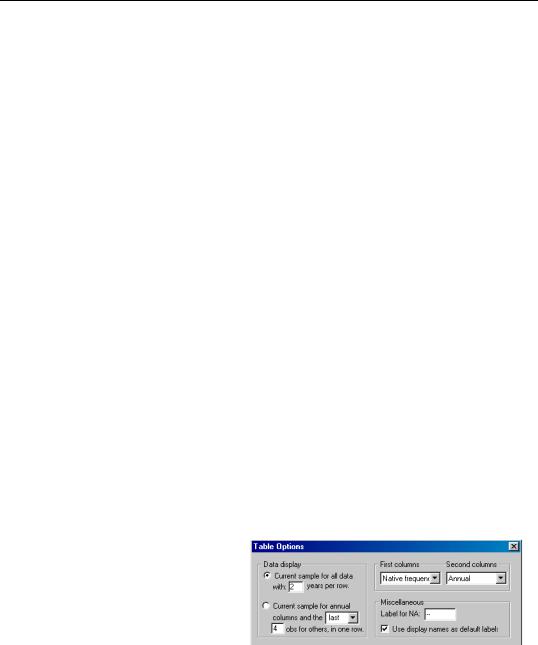
366—Chapter 12. Groups
Alternatively, you may wish to display annual averages for each year up to the last, followed by the last four quarterly observations in your sample:
|
1994 |
1995 |
1996 |
96:1 |
96:2 |
96:3 |
96:4 |
GDP |
1736.8 |
1816.4 |
1909.0 |
1866.9 |
1902.0 |
1919.1 |
1948.2 |
PR |
1.05 |
1.08 |
1.10 |
1.09 |
1.10 |
1.11 |
1.11 |
Again, the dated data table may be used to perform the required calculations and to set up the table automatically.
The dated data table is capable of creating more complex tables and performing a variety of other calculations. Note, however, that the dated data table view is currently available only for annual, semi-annual, quarterly, or monthly workfiles.
Creating and Specifying a Dated Data Table
To create a dated data table, create a group containing the series of interest and select View/Dated Data Table. The group window initially displays a default table view. The default is to show a single year of data on each line, along with a summary measure (the annual average).
You can, however, set options to control the display of your data through the Table and Row Options dialogs. Note the presence of two new buttons on the group window toolbar, labeled TabOptions (for Table Options) and RowOptions. TabOptions sets the global options for the dated data table. These options will apply to all series in the group object. The RowOptions button allows you to override the global options for a particular series. Once you specify table and row options for your group, EViews will remember these options the next time you open the dated data table view for the group.
Table Setup
When you click on the TabOptions button, the Table Options dialog appears. The top half of the dialog provides options to control the general style of the table.
The radio buttons on the left hand side of the dialog allow you to choose between the two display formats described above:
•The first style displays the data for n years per row, where n is the positive integer specified in the edit field.
•The second style is a bit more complex. It allows you to specify, for data displayed at a frequency other than annual, the number of observations taken from the end of the

Dated Data Table—367
workfile sample that are to be displayed. For data displayed at an annual frequency, EViews will display observations over the entire workfile sample.
The two combo boxes on the top right of the dialog supplement your dated display choice by allowing you to display your data at multiple frequencies in each row. The First Columns selection describes the display frequency for the first group of columns, while the Second Columns selection controls the display for the second group of columns. If you select the same frequency, only one set of results will be displayed.
In each combo box, you may choose among:
•Native frequency (the frequency of the workfile)
•Annual
•Quarterly
•Monthly
If necessary, EViews will perform any frequency conversion (to a lower frequency) required to construct the table.
The effects of these choices on the table display are best described by the following example. For purposes of illustration, note that the current workfile is quarterly, with a current sample of 1993Q1–1996Q4.
Now suppose that you choose to display the first style (two years per row), with the first columns set to the native frequency, and the second columns set to annual frequency. Each row will contain eight quarters of data (the native frequency data) followed by the corresponding two annual observations (the annual frequency data):
|
Q1 |
Q2 |
Q3 |
Q4 |
|
Q1 |
Q2 |
Q3 |
Q4 |
|
Year |
|
|
|
1993 |
|
|
|
|
1994 |
|
1993 |
1994 |
GDP |
1611.1 |
1627.3 |
1643.6 |
1676.0 |
1698.6 |
1727.9 |
1746.7 |
1774.0 |
1639.5 |
1736.8 |
|
PR |
1.02 |
1.02 |
1.03 |
1.04 |
1.04 |
1.05 |
1.05 |
1.06 |
1.03 |
1.05 |
|
|
|
|
1995 |
|
|
|
|
1996 |
|
1995 |
1996 |
GDP |
1792.3 |
1802.4 |
1825.3 |
1845.5 |
1866.9 |
1902.0 |
1919.1 |
1948.2 |
1816.4 |
1909.0 |
|
PR |
1.07 |
1.07 |
1.08 |
1.09 |
1.09 |
1.10 |
1.11 |
1.11 |
1.08 |
1.10 |
|
EViews automatically performs the frequency conversion to annual data using the specified method (see “Transformation Methods” on page 368).
If you reverse the ordering of data types in the first and second columns so that the first columns display the annual data, and the second columns display the native frequency, the dated data table will contain:
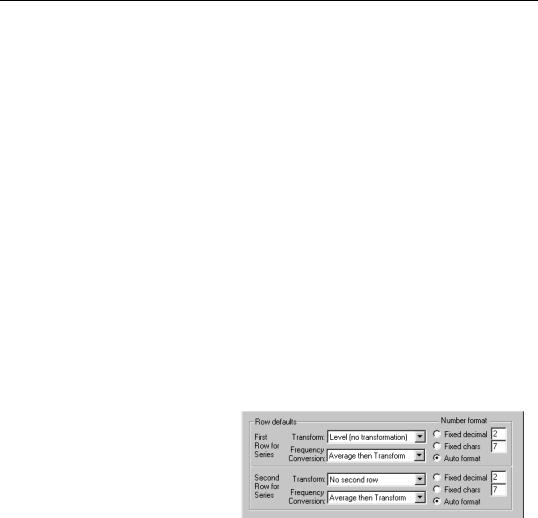
368—Chapter 12. Groups
|
|
|
Q1 |
Q2 |
Q3 |
Q4 |
|
Q1 |
Q2 |
Q3 |
Q4 |
|
1993 |
1994 |
|
|
1993 |
|
|
|
|
1994 |
|
GDP |
1639.5 |
1736.8 |
1611.1 |
1627.3 |
1643.6 |
1676.0 |
1698.6 |
1727.9 |
1746.7 |
1774.0 |
|
PR |
1.03 |
1.05 |
1.02 |
1.02 |
1.03 |
1.04 |
1.04 |
1.05 |
1.05 |
1.06 |
|
|
1995 |
1996 |
|
|
1995 |
|
|
|
|
1996 |
|
GDP |
1816.4 |
1909.0 |
1792.3 |
1802.4 |
1825.3 |
1845.5 |
1866.9 |
1902.0 |
1919.1 |
1948.2 |
|
PR |
1.08 |
1.10 |
1.07 |
1.07 |
1.08 |
1.09 |
1.09 |
1.10 |
1.11 |
1.11 |
|
Now, click on TabOptions, choose the second display style, and enter 4 in the edit box. Then specify Annual frequency for the first columns and Native frequency for the second columns. EViews will display the annual data for the current sample, followed by the last four quarterly observations:
|
1993 |
1994 |
1995 |
1996 |
96:1 |
96:2 |
96:3 |
96:4 |
GDP |
1639.5 |
1736.8 |
1816.4 |
1909.0 |
1866.9 |
1902.0 |
1919.1 |
1948.2 |
PR |
1.03 |
1.05 |
1.08 |
1.10 |
1.09 |
1.10 |
1.11 |
1.11 |
Additional Table Options
The bottom of the Table Options dialog controls the default data transformations and numeric display for each series in the group. EViews allows you to use two rows, each with a different transformation and a different output format, to describe each series.
For each row, you specify the transformation method, frequency conversion method, and the number format.
Keep in mind that you may override the default transformation for a particular series using the RowOptions menu (p. 371).
Transformation Methods
The following transformations are available:
None (raw data) |
No transformation |
|
|
1 Period Difference |
( y − y( −1 ) ) |
|
|
|
|
|
|
|
Dated Data Table—369 |
|
|
|
|
|
|
|
|
|
|
|
|
|
|
|
|
1 |
Year Difference |
|
|
|
|
|
|
|
1 |
for annual |
|
|
|
|
|
|
|
||
|
|
|
|
2 |
for semi-annual |
|
|
|
|
y − y( −f) , wheref = |
|
|
|
|
|
|
|
4 |
for quarterly |
|
|
|
|
|
12 for monthly |
|
|
|
|
|
|
|
||
|
|
|
|
|
|
|
|
1 |
Period % Change |
100 × ( y − y( −1) ) ⁄ y( −1) |
|
|
|
|
1 |
Period % Change at |
Computes R such that: |
|
|
|
|
Annual Rate |
( 1 + r |
⁄ 100 )f |
|
||
|
|
|
|
|||
|
|
|
where f is defined above and r is the 1 period% |
|
||
|
|
|
change. |
|
|
|
|
|
|
|
|
||
|
1 |
Year % Change |
100 × ( y − y( −f) ) ⁄ y( −f) , where f is defined |
|
||
|
|
|
above. |
|
|
|
|
|
|
|
|
||
|
No second row |
Do not display a second row |
|
|
||
|
|
|
|
|
|
|
We emphasize that the above transformation methods represent only the most commonly employed transformations. If you wish to construct your table with other transformations, you should add an appropriate auto-series to the group.
Frequency Conversion
The following frequency conversion methods are provided:
Average then Trans- |
First convert by taking the average, then trans- |
form |
form the average, as specified. |
|
|
Transform then Aver- |
First transform the series, then take the aver- |
age |
age of the transformed series. |
|
|
Sum then Transform |
First convert by taking the sum, then trans- |
|
form the sum, as specified. |
|
|
First Period |
Convert by taking the first quarter of each year |
|
or first month of each quarter/year. |
|
|
Last Period |
Convert by taking the last quarter of each year |
|
or last month of each quarter/year. |
|
|
The choice between Average then Transform and Transform then Average changes the ordering of the transformation and frequency conversion operations. The methods differ only for nonlinear transformations (such as the % change methods).
For example, if we specify the dated data table settings:
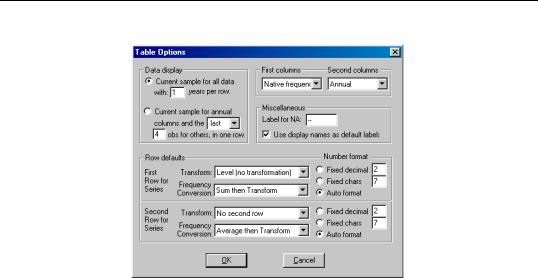
370—Chapter 12. Groups
EViews will display a table with data formatted in the following fashion:
|
Q1 |
Q2 |
Q3 |
Q4 |
Year |
|
|
|
1993 |
|
1993 |
GDP |
1611.1 |
1627.3 |
1643.6 |
1676.0 |
6558.1 |
PR |
1.02 |
1.02 |
1.03 |
1.04 |
4.11 |
|
|
|
1994 |
|
1994 |
GDP |
1698.6 |
1727.9 |
1746.7 |
1774.0 |
6947.1 |
PR |
1.04 |
1.05 |
1.05 |
1.06 |
4.20 |
|
|
|
1995 |
|
1995 |
GDP |
1792.3 |
1802.4 |
1825.3 |
1845.5 |
7265.4 |
PR |
1.07 |
1.07 |
1.08 |
1.09 |
4.31 |
|
|
|
1996 |
|
1996 |
GDP |
1866.9 |
1902.0 |
1919.1 |
1948.2 |
7636.1 |
PR |
1.09 |
1.10 |
1.11 |
1.11 |
4.41 |
If, instead, you change the Frequency Conversion to First Period, EViews will display a table of the form:
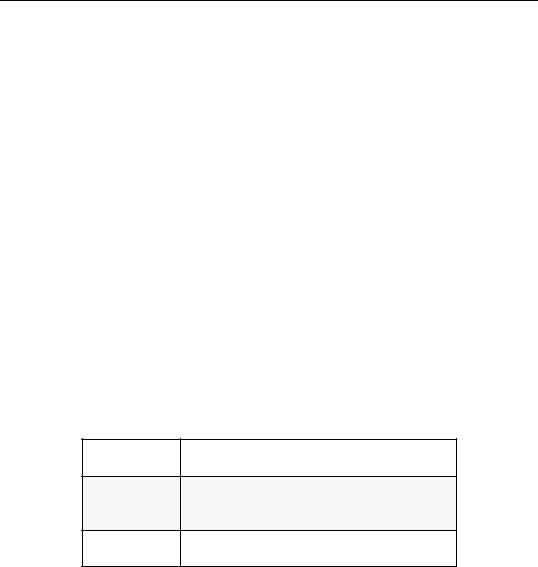
Dated Data Table—371
|
Q1 |
Q2 |
Q3 |
Q4 |
Year |
|
|
|
1993 |
|
1993 |
GDP |
1611.1 |
1627.3 |
1643.6 |
1676.0 |
1611.1 |
PR |
1.02 |
1.02 |
1.03 |
1.04 |
1.02 |
|
|
|
1994 |
|
1994 |
GDP |
1698.6 |
1727.9 |
1746.7 |
1774.0 |
1698.6 |
PR |
1.04 |
1.05 |
1.05 |
1.06 |
1.04 |
|
|
|
1995 |
|
1995 |
GDP |
1792.3 |
1802.4 |
1825.3 |
1845.5 |
1792.3 |
PR |
1.07 |
1.07 |
1.08 |
1.09 |
1.07 |
|
|
|
1996 |
|
1996 |
GDP |
1866.9 |
1902.0 |
1919.1 |
1948.2 |
1866.9 |
PR |
1.09 |
1.10 |
1.11 |
1.11 |
1.09 |
In “Illustration” beginning on page 372, we provide an example which illustrates the computation of the percentage change measures.
Formatting Options
EViews lets you choose between fixed decimal, fixed digit, and auto formatting of the numeric data. Generally, auto formatting will produce appropriate output formatting, but if not, simply select the desired method and enter an integer in the edit field. The options are:
Auto format EViews chooses the format depending on the data.
Fixed decimal Specify how many digits to display after the decimal point. This option aligns all numbers at the decimal point.
Fixed chars Specify how many total characters to display for each number.
EViews will round your data prior to display in order to fit the specified format. This rounding is for display purposes only and does not alter the original data.
Row Options
These options allow you to override the row defaults specified by the Table Options dialog. You can specify a different transformation, frequency conversion method, and number format, for each series.

372—Chapter 12. Groups
In the Series Table Row Description dialog that appears, select the series for which you wish to override the table default options. Then specify the transformation, frequency conversion, or number format you want to use for that series. The options are the same as those described above for the row defaults.
Other Options
Label for NA: allows you to define the symbol used to identify missing values in the table. Bear in mind that if you choose to display
your data in transformed form, the transformation may generate missing values even if none of the raw data are missing. Dated data table transformations are explained above.
If your series has display names, you can use the display name as the label for the series in the table by selecting the Use display names as default labels option. See Chapter 3 for a discussion of display names and the label view.
Illustration
As an example, consider the following dated data table which displays both quarterly and annual data for GDP and PR in 1995 and 1996:
|
|
|
1995 |
|
1995 |
GDP |
1792.3 |
1802.4 |
1825.3 |
1845.5 |
1816.4 |
(% ch.) |
1.03 |
0.56 |
1.27 |
1.11 |
4.58 |
PR |
1.07 |
1.07 |
1.08 |
1.09 |
1.08 |
(% ch.) |
0.80 |
0.49 |
0.52 |
0.55 |
2.55 |
|
|
|
1996 |
|
1996 |
GDP |
1866.9 |
1902.0 |
1919.1 |
1948.2 |
1909.0 |
(% ch.) |
1.16 |
1.88 |
0.90 |
1.52 |
5.10 |
PR |
1.09 |
1.10 |
1.11 |
1.11 |
1.10 |
(% ch.) |
0.72 |
0.41 |
0.64 |
0.46 |
2.27 |
At the table level, the first row of output for each of the series is set to be untransformed, while the second row will show the 1-period percentage change in the series. The table defaults have both rows set to perform frequency conversion using the Average then

Dated Data Table—373
Transformed setting. In addition, we use Series Table Row Options dialog to override the second row transformation for PR, setting it to Transform then Average option.
The first four columns show the data in native frequency so the choice between Average then Transform and Transform then Average is irrelevant—each entry in the second row measures the 1-period (1-quarter) percentage change in the variable.
The 1-period percentage change in the last column is computed differently under the two methods. The Average then Transformed percentage change in GDP for 1996 measures the percentage change between the average value in 1995 and the average value in 1996. It is computed as:
100 ( 1909.0 − 1816.3 ) ⁄ 1816.4 5.10 |
(12.1) |
EViews computes this transformation using full precision for intermediate results, then displays the result using the specified number format.
The computation of the Transform then Average one-period change in PR for 1996 is a bit more subtle. Since we wish to compute measure of the annual change, we first evaluate the one-year percentage change at each of the quarters in the year, and then average the results. For example, the one-year percentage change in 1996Q1 is given by 100(1.09-1.03)/ 1.03=2.29 and the one-year percentage change in 1996Q2 is 100(1.10-1.07)/1.07=2.22. Averaging these percentage changes yields:
100 |
|
1.09 − 1.07 |
+ |
1.10 − 1.07 |
+ |
1.11 − 1.08 |
+ |
1.11 − 1.09 |
⁄ 4 2.27 (12.2) |
|
--------------------------1.07 - |
--------------------------1.07 - |
--------------------------1.08 - |
--------------------------1.09 - |
Note also that this computation differs from evaluating the average of the one-quarter percentage changes for each of the quarters of the year.
Other Menu Items
•Edit+/– allows you to edit the row (series) labels as well as the actual data in the table. You will not be able to edit any of the computed ranks and any changes that you make to the row labels will only apply to the dated data table view.
We warn you that if you edit a data cell, the underlying series data will also change. This latter feature allows you to use dated data tables for data entry from published sources.
If you want to edit the data in the table but wish to keep the underlying data unchanged, first Freeze the table view and then apply Edit to the frozen table.
•Font allows you to choose the font, font style, and font size to be used in the table.
•Title allows you to add a title to the table.
•Sample allows you to change the sample to display in the table.
